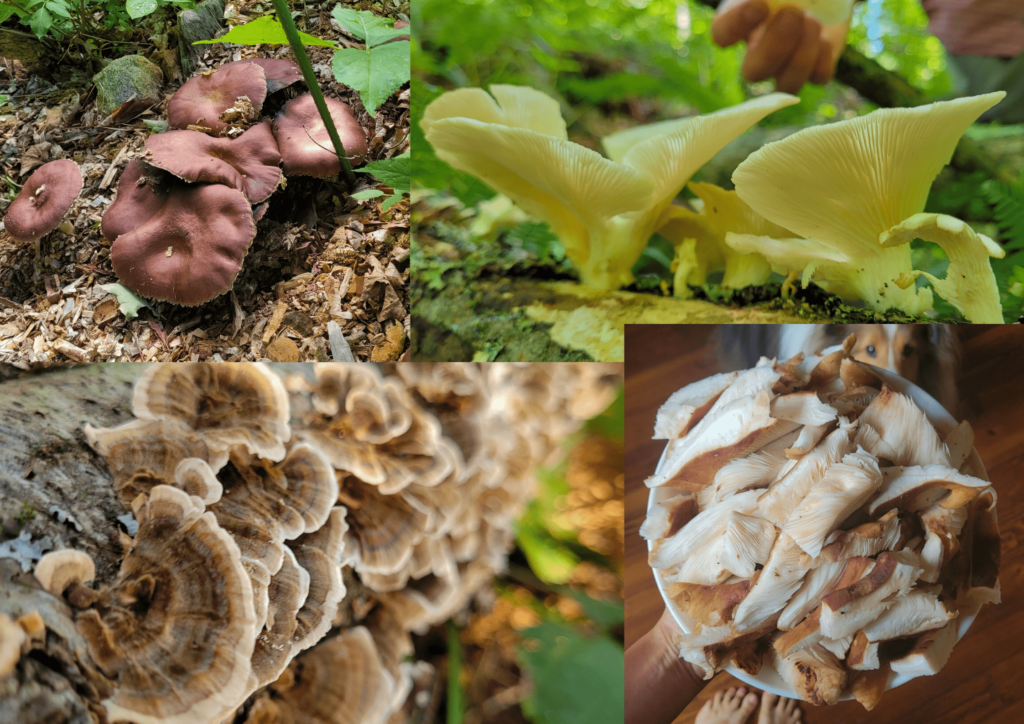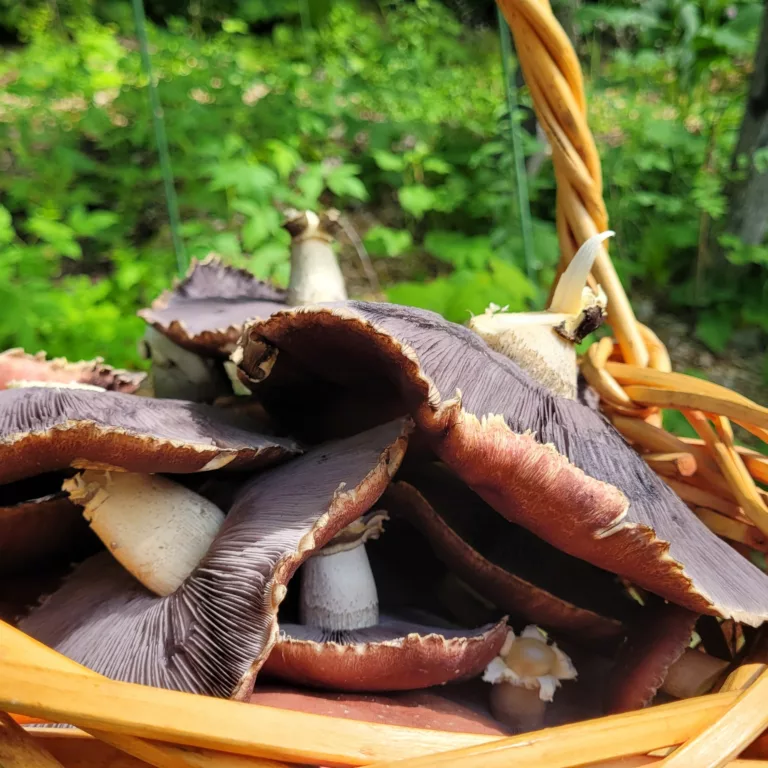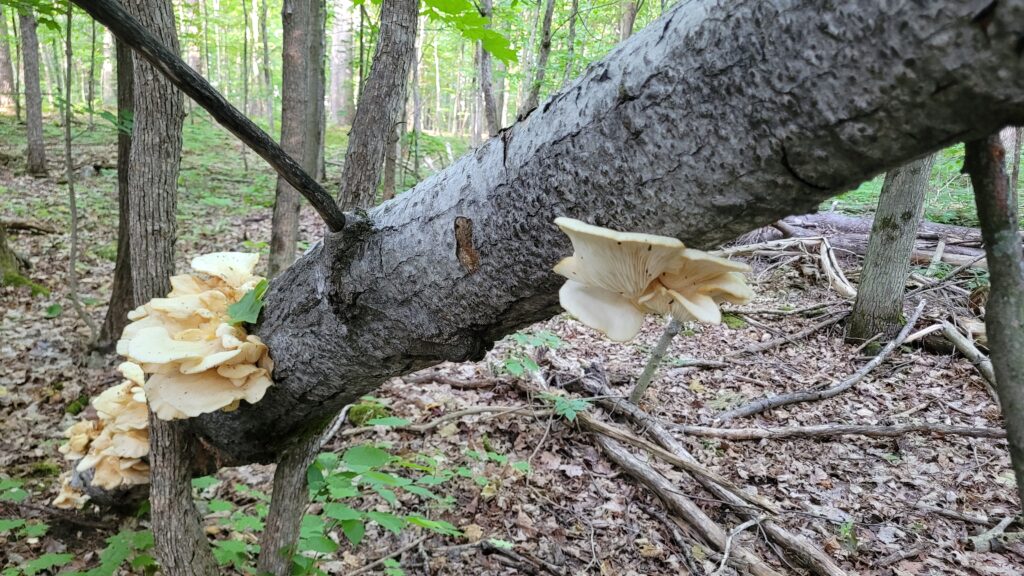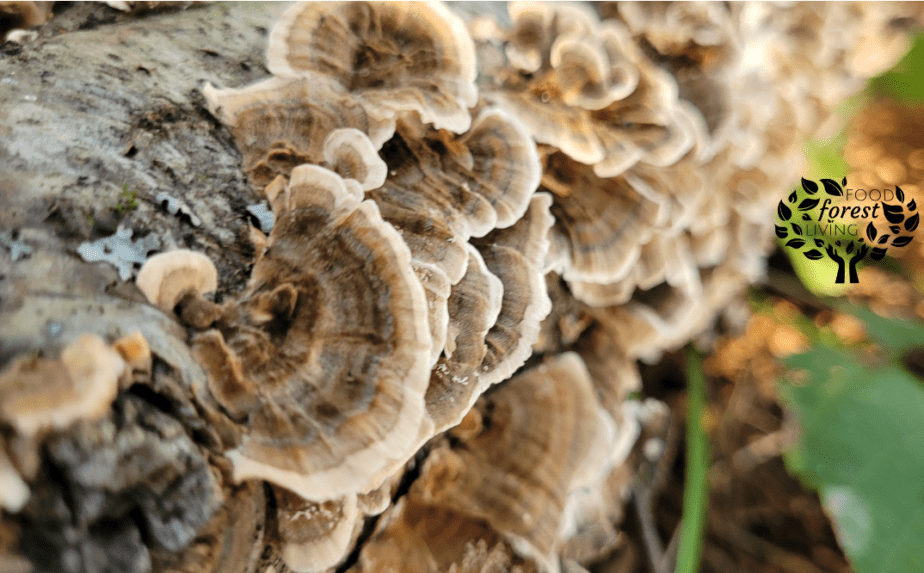This post may contain affiliate links. If you use these links to buy something we may earn a commission. Thanks.
Above all other species, fail-proof mushrooms are the easiest to grow and are the best options for beginners.
What’s even better news, is this list actually leads you to more than 4 easy mushrooms to grow because each species offers several varieties that are all equally easy to cultivate outdoors.
Several other species of mushrooms can be grown outside, but these are easier than all others. This list of mushrooms will not only be the easiest for you to ‘get right’ but provide you with high yields of fruit. (Fruit; meaning mushrooms!)
And the best news is that with a little upfront effort, growing mushrooms outside is passively productive years after. You’ll be harvesting your mushrooms for 2-6 years (or more) with a relatively simple setup.
Related: Grow a Mushroom Garden at Home in 4 Steps

These easy mushrooms are not only grown with little to fuss about but some fruit pretty quickly.
When I was first starting out, I wondered which were the fastest to grow because I wanted to eat them as soon as I could!
Oyster and wine cap mushrooms colonize and fruit the fastest. In spring, inoculate a bed of straw with spawn, and you’ll get fruit in autumn as soon as the temperatures are right. You could also make your mushroom beds in autumn and expect fruit next spring.
New flushes will keep coming until temperatures get too cold (or too warm). Oyster mushrooms and wine caps are very aggressive strains. They aren’t easily outcompeted and they like to ‘work’ quickly.
For the next two years, you’ll get prolific harvests. If you top up your beds with new material every year and gently mix it into the first inch, fruit is likely to continue on!
What are the easiest mushrooms to grow outside?
The easiest mushrooms to grow outdoors are:
- King Stropharia (Wine caps)
- Oyster mushrooms (Snow, Yellow, Blue)
- Shiitake (Warm, cold, and wide-range strains)
- Turkey tail
Several factors make these the easiest outdoor producers. But what they all have in common is an aggressive nature! These mushrooms have no problem out-competing most wild strains.
Each, however, has distinct characteristics. Based on how they grow, ways to use them, and more, you’ll decide which ones you’re most interested in adding to your garden.
Wine caps (King Stropharia)

The easiest mushroom of all is King Stropharia. They are native across North America, cold tolerant to winters, and fruit in a wide temperature span of 50-70°F (10-22°C).
While many others say the easiest is oysters, I claim it’s wine caps.
Why? While they are both aggressive growers, wine caps prefer to grow exclusively in mushroom beds (rather than on logs).
Mushroom beds are way easier and more accessible for the average person than logs are. Fresh healthy hardwood logs, that aren’t too old, are hard to come by unless you cut them yourself. And quality logs are essential for success, but less critical for chips.
To grow wine caps, all you’ll need is fresh straw, woodchips, and sawdust spawn! (on sale now, but if you miss it, you can still get a discount using QUALITYSPAWN at checkout.)
See: How do you make (and maintain) an outdoor mushroom bed?
If straw is easier to get than woodchips, or vice versa, you can use a single type of medium, too. Leaves also work in a mix with either, but I wouldn’t use leaves only.
I recommend mixing mediums. When using both straw and woodchips, you’ll get wine cap harvests sooner AND later. Straw is colonized faster than woodchips. Once colonized, you’ll get fruit.
Straw is also consumed quicker than woodchips, so while the straw is producing fruit, the woodchips will colonize. Once the straw is consumed, woodchips will fruit! And woodchips will fruit for longer than straw—This is our experience! These guys also agree that a mixed medium bed is ultimately more productive.
Be sure to top up your beds every year with new straw and woodchips so they have more fuel to continue thriving.
But you don’t have to make and maintain a designated stationary bed for wine caps. Wine caps can travel and spread around a perennial dominant garden.
They’re the most popular choice for fulfilling the “mushroom layer” of a permaculture garden. Every permaculturist needs wine caps in their food forest—since it’s the easiest one to add!
Wine caps benefit your garden by breaking down mulch into available nutrients for plants. It’s like a crawling composter—whether you add cultivated fungi (such as wine caps) or not, some form of mushroom will eventually claim this job. So why not an edible species?
Since your wine caps will grow in sun or shade, they’ll also provide you with vitamin D!
The size of wine caps makes them go a long way when cooked. The cap flavor is pretty neutral, and the stems are a bit mustier. We tend to eat mainly the caps as they are the tastiest portion of any King Stropharia mushroom! We compost excessive portions of stem, but you can eat them if you like them!
Barbequed or air-fried, wine cap mushrooms are delicious.
Oyster mushrooms

Oyster mushrooms are the most popular beginner mushrooms to grow because they taste sweet, are easy, and grow on various substrates.
Outside, you can grow oyster mushrooms on both hardwood logs and straw or woodchip beds.
Related: Are Mushroom Logs Worth It? All You Need to Know
Multiple oyster varieties are available for you to try. Some may be more ideal for you than others.
In general, all oyster mushroom strains taste sweet and grow prolifically on whichever substrate is easiest for you. Strains differ in temperature tolerance, color, and timing of fruit.
- Blue oyster mushrooms:
- Are high-yielding and considered one of the most productive species
- Fruit in temperatures from 55-75°F (13-24°C) and seasonally cold-tolerant
- Grain spawn is used to make straw or woodchip beds
- Sawdust spawn is used to make logs (in bulk) or beds
- Plug spawn is used to make logs
- Golden oyster mushrooms:
- Fruit prolifically in humid tropical summers
- Fruit in temperatures from 65-80°F (18-26°C) and are not cold-tolerant
- Grain spawn is used to make straw or woodchip beds
- Sawdust spawn is used to make logs (in bulk) or beds
- Plug spawn is used to make logs
- Snow oyster mushrooms:
- Are an early firm fruiter as they do best in cool temperatures
- Fruit in temperatures from 45-65°F (7-18°C) and seasonally cold-tolerant
- Grain spawn is used to make straw or woodchip beds
- Sawdust spawn is used to make logs (in bulk) or beds
- Plug spawn is used to make logs
- Pink oyster mushrooms:
- Pink oysters are dense in texture and fruit in tropical climate summers
- Fruit in temperatures from 70-80°F (21-26°C) and are not cold-tolerant
- Gain spawn is used to make straw or woodchip beds
- Sawdust spawn is used to make logs (in bulk) or beds
- Italian oyster mushrooms:
- Are big, thick, and meaty mushrooms
- Fruit in temperatures from 65-75°F (18-24°C) and cold tolerant
- Grain spawn is used to make straw or woodchip beds
- Sawdust spawn is used to make logs (in bulk) or beds
- Plug spawn is used to make logs
If you live in a cold climate, maximize your mushroom harvest window by growing blue, snow, and Italian oysters. If you also want to taste tropical varieties, you’ll have to grow them indoors. In that case, you could try a “spray and grow” kit before committing to an indoor BoomRoom!
Get a discount this month using QUALITYSPAWN at checkout.
Several oyster mushrooms grow in varying temperatures and climates to the point you could forage them year-round in some areas.
As they are generally prevalent worldwide, they are also known for various health benefits. As detailed in that publication, oyster mushrooms have a composition that benefits our immunity, eyes, hearts, cells, and more.
Oyster mushrooms are delicious no matter what you do with them! Their texture reminds me of seafood.
Shiitake

Shiitake mushrooms are another popular species to grow since they are beginner-friendly.
They are thicker and meatier than oysters and absolutely delicious. (But oyster mushrooms are great too! They’re generally ‘seafoodie’ in texture but sweet-smelling!)
Dried shiitakes are often used in Asian cuisine, but when used fresh it’s a whole new world!
Shiitake mushrooms offer various benefits beyond their taste and texture!
Not only are they highly nutritious, but both shiitake and oyster mushrooms show antifungal and antibacterial effects. With antibiotic-resistance concerns, why not have your own “farmacy” on the go?
Furthermore, shiitake mushrooms have been consumed to prevent cancers, and heart diseases, improve blood circulation, and many more ailments (source).
Grow shiitakes indoors or outdoors for best results. Indoor growing can allow you to have them year-round as long as you keep production going.
When grown outdoors, they’ll fruit during the right temperatures which are between 7-21C (45-70F), once colonized. We harvest the bulk of our shiitakes from summer to fall.
Shiitake mushrooms can be grown on logs outside with plug spawn or sawdust spawn. Shiitakes aren’t generally cultivated on beds outdoors, making them a little less easy to grow than oysters and wine caps.
If you’re unable to make mushroom logs, you can grow shiitake mushrooms indoors using sawdust or straw substrate, to do so, you’ll need either sawdust spawn or grain spawn.
The best place to put shiitake logs outside is under a humid canopy that receives rain and snow.
Turkey tail

Turkey tail mushrooms are like the Jerusalem artichokes of gardening. Jerusalem artichokes grow in all “zones” so what I mean by that, is turkey tail is a species of mushroom that grows wild worldwide.
Different parts of the world might get varying strains of turkey tail—But it’s all turkey tail!
If you’re into tea and healing, turkey tail mushrooms are a good addition to any medicinal garden.
As one of the most researched mushroom for medicine, it’s been used to fight various cancers and aid in quicker recoveries.
To consume turkey tail, brew it into a nourishing (and tasty) tea! You won’t want to eat the mushroom as it’s like cardboard in texture.
Turkey tail tea has a very full-bodied semi-sweet mild mushroom flavor.
What makes turkey tail so easy to grow is their aggressive nature.
Quick story-time: the very first set of mushroom logs we made, we used old and diseased wood. Our lion’s mane and chicken of the woods completely failed—we got nothing from them. Four of the multiple shiitake logs only produced 1-6 mushrooms each, but the turkey tail logs all produced loads! We have years’ of dried turkey tail for tea.
So I say turkey tail is among the easiest of mushrooms to grow, perhaps easier than shiitake, since they will produce (and outperform other easy types) on logs that aren’t in good condition.
Good logs are essential for success for all mushroom strains, but turkey tail proved that not entirely true. I’d say it’s true for all mushroom species but turkey tail, however, healthy fresh logs are always more worth your while.
I don’t recommend using sub-par logs for any mushroom log project. But if you must, turkey tail is the most suitable choice for your best chance at success if it’s all you have. We grew ours on old ironwood.
Up Next: Where to Find Fresh Wood for Mushroom Logs (9 Places)
Recent Posts
There’s no shortage of full-sun ground covers for zone 4 climates! Each plant in this list can withstand the frigid temperatures and also enjoy the hot sun in summer. Full sun means that a plant...
There's no shortage of full sun ground covers, not even in zone 3! Zone 3 climates offer hot but short-lived summers and very cold winters. So each plant in this list can withstand the frigid...
